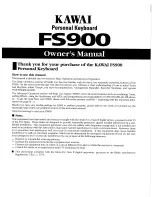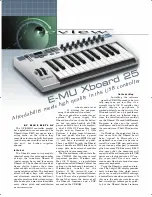
4
TOOLS for MOTIF ES6/MOTIF ES7/MOTIF ES8 Installation Guide
Minimum System Requirements
The system requirements below may differ slightly depending on the particular
operating system.
• SQ01 V2
OS:
Windows 98/Me/2000/XP Home Edition/
XP Professional
Computer:
500 MHz or higher; Intel Pentium/Celeron processor
(750 MHz or higher when using Windows XP)
Available Memory:
256 MB or more
Hard Disk:
300 MB or more
Display:
1024 x 768 dots or more
•
Voice Editor for MOTIF ES6/7/8
OS:
Windows 98/Me/2000/
XP Home Edition/XP Professional
Computer:
166 MHz or higher;
Intel Pentium/Celeron processor
Available Memory:
32 MB or more
Hard Disk:
24 MB or more
Display:
640 x 480, High Color (16 bit) or higher
•
Multi Part Editor for MOTIF ES6/7/8
OS:
Windows 98/Me/2000/XP Home Edition/
XP Professional
Computer:
166 MHz or higher;
Intel Pentium/Celeron processor
Available Memory:
32 MB or more
Hard Disk:
32 MB or more
Display:
1024 x 768, High Color (16 bit) or higher
•
TWE V2.4.4
OS:
Windows 95/98/Me/2000/NT/XP
Computer:
166 MHz or higher;
Intel Pentium/Celeron processor
Available Memory:
24 MB or more
Hard Disk:
Average access time 30 ms or less
Display:
800 x 600, 256 colors or more
•
USB MIDI Driver
OS:
Windows 98/Me/2000/XP Home Edition/
XP Professional
Computer:
166 MHz or higher;
Intel Pentium/Celeron processor
Available Memory:
32 MB or more
(64 MB or more is recommended)
Hard Disk:
2 MB or more
n
The Minimum System Requirements described above are current as of June 2003.
Keep in mind that the software is often updated and the system requirements are subject
to change. You can check the latest version information of each program and its system
requirements at the following website.
http://www.yamaha.co.jp/product/syndtm/index.html
Software Installation
Uninstall (Removing the installed applictaion)
To remove the installed applictaion software:
Select [START]
→
[Settings]
→
[Control Panel]
→
[Add/Remove
Programs]
→
[Install/Uninstall], then select the application to be
removed and click [Add/Remove...].
Follow the on-screen instructions to uninstall the application.
n
The button names or menus may differ depending on the computer OS.
• • • • • • • • • • • • • • • • • • • • • • • • • • • • • • • • • • • • • • • • • • • • • • • • • • • • • • • • • • •
Acrobat Reader
In order to view the electronic (PDF) manuals included with each application,
you’ll need to install Acrobat Reader.
n
If an older version of Acrobat Reader is installed on your PC, you’ll need to uninstall it
before proceeding.
1
Double-click on the “Acroread_” folder.
Four different language folders will be displayed.
2
Select the language you want to use and double-click on its folder.
The file “ar***.exe” file will be displayed. (“***” indicates the selected
language.)
3
Double-click on “ar***.exe.”
Acrobat Reader Setup Dialog box will be displayed.
4
Execute the installation by following the on-screen directions.
After installation is complete, the Acrobat folder appears on your PC (in
Program Files, as the default).
For information on using the Acrobat Reader, refer to the Reader Guide in the
Help menu.
• • • • • • • • • • • • • • • • • • • • • • • • • • • • • • • • • • • • • • • • • • • • • • • • • • • • • • • • • • •
USB MIDI Driver
To operate the MOTIF ES from your computer via USB, you’ll need to install
the appropriate driver software.
The USB-MIDI driver is software that transfers MIDI data back and forth
between sequence software and the MOTIF ES via a USB cable.
For Windows 98/Me: See below.
For Windows 2000: See page 5.
For Windows XP: See page 5.
Installing the driver on Windows 98/Me
1
Start the computer.
2
Insert the included CD-ROM into the CD-ROM drive.
3
First, make sure the POWER switch on the MOTIF ES is set to OFF, then
use a USB cable to connect the USB terminal of the computer (or the USB
hub) to the USB TO HOST connector of the MOTIF ES. When the MOTIF
ES is turned on, the computer automatically displays the “Add New
Hardware Wizard.” If the Add New Hardware Wizard does not appear, click
“Add New Hardware” in the Control Panel.
n
For Windows Me users, check the radio button to the left of “Automatic search for a
better driver (Recommended)” and click [Next]. The system automatically starts
searching and installing the driver. Proceed to Step 8. If the system does not detect
the driver, select “Specify the location of the driver (Advanced)” and specify the
CD-ROM drive’s “USBdrv_” folder to install the driver.
4
Click [Next].
The window enables you to select the search method.
5
Check the radio button to the left of “Search for the best driver for your
device. (Recommended).” Click [Next]. The window enables you to select a
location in which to install the driver.
6
When using Windows 98, check the “Specify a location” box, click
“Browse..”, then specify the USBdrv directory of the CD-ROM drive (such
as D:\USBdrv_\) and continue the installation.
When using Windows Me, check the “CD-ROM drive” box and uncheck all
other items. Click [Next].
n
When using Windows Me, the system may ask you to insert a Windows CD-ROM
while it checks for the driver. Specify the USBdrv directory of the CD-ROM drive
(such as D:\USBdrv_\) and continue the installation.
7
When the system detects the driver on the CD-ROM and is ready for
installation, it is shown as a message on the screen.
Make sure that the “YAMAHA USB MIDI Driver” is listed, and click
[Next]. The system starts the installation.
8
When installation is complete, a message indicating so appears.
Click [Finish].
n
Some computers may take about ten seconds to show this screen after the
installation is complete.
The driver has been installed.
Computer
MOTIF ES
USB cable
Driver
Sequence
Software
English





































